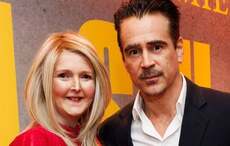Robert Redford is famous for his groundbreaking films and the boundary-pushing Sundance Film Festival, but did you know he’s just as comfortable talking about Irish poets?
As an actor he’s been respected for generations, but as an activist his work is still under appreciated. Now Michael Feeney Callan’s definitive biography plans to give Redford his due. He talks to CAHIR O’DOHERTY about his long and sometimes difficult friendship with one of the titans of American film.
Butch and Sundance. The image of Paul Newman and Robert Redford as a pair of charismatic outlaws is now one of the most famous images in the history of Hollywood.
But as with almost every film committed to celluloid, at the time the two actors didn’t realize they were creating a near instant classic.
Thank George Hill for that, their gifted Irish American director (both of his parents were native Dubliners) who pushed Redford and Newman’s performances in a direction no other filmmaker would have dared to at the time.
Honesty was what Hill was after, not glory, and that’s what makes Butch Cassidy and the Sundance Kid such a signature film in Redford’s career.
Redford’s been famous so long we all think we know him. But even a short look at his life and work reveals that’s not true at all.
A restless and rootless wanderer of a man, Redford has been described as virtually unknowable by many of those who are closest to him. That’s exactly the kind of professional challenge a good biographer can’t resist.
Michael Feeney Callan is a native Dubliner who first made his reputation as a writer and playwright. Feeney Callan is the author of well-regarded biographies of Anthony Hopkins, Richard Harris, Sean Connery and others.
In the eighties Feeney Callan was at the helm of Ireland’s fabled Ardmore Film Studios (film business in his blood) and his new book Robert Redford, The Biography (Knopf, $28.95) was 15 years in the making. If he sounds invested in it (and he does) it’s because it’s the work of a lifetime.
“Redford had liked the biography I had written on Anthony Hopkins and that brought me to him originally,” Feeney Callan tells the Irish Voice.
“The problem with Redford is that there’s this Hollywood hyperbole surrounding him. It never ceases to amaze me how people believe the regurgitated mythology of the tabloids that’s going on all the time.”
Rescuing Redford’s reputation from shoddy journalism is something of a mission for this most disciplined of biographers, and his obvious passion for the issue underlines why he was the ideal candidate for the job.
Feeney Callan both admires and retains his critical distance from his famous subject at all times, and he has no time for celebrity chatter.
“There are repeated media myths about how Redford got started that are not in my book. In fact one of the main reasons that I tackled and locked horns with Redford was in the very beginning I had made a decision that I was not going to write a celebrity biography, I was going to treat his work and American film culture with the historical gravitas it actually deserves,” says Feeney Callan.
“I decided to take a film star and treat him in the same way we would traditionally treat a famous writer like Emily Dickinson or Walt Whitman for example.”
The reason that Feeney Callan took that unusual root is because American culture is so comparatively new (it’s only 150 years since the publication of The Scarlet Letter, which he calls the first great discernibly American novel) and American film culture’s global impact and influence has been unprecedented in world culture.
“I approached the book as being about appreciating Redford as an undervalued American artist. I was particularly interested at looking at the work he did as a producer because he was really often a ghostwriter too,” says Feeney Callan. “Because Redford was such a luminously attractive star, it had detracted from seeing the American cultural value of his work in the films he had produced and directed.”
Treating a film star to the rigors of academic history is interesting enough, but in this era of pop culture and resistance to any kind of scholarship, it’s practically heroic.
“Everything that’s been reported about Redford, including that he was born before his parents were married, that he was a baseball prodigy, so many of these things are untrue,” says the author.
Think of Redford as a global artistic force because he has been, Feeney Callan says. Think of him as someone more than just another Hollywood star, because if he wasn’t he would never have chosen him as a subject.
And don’t think any of it was easy.
“He’s an ornery bastard, he’s difficult to deal with, he’s nothing if not stubborn and awkward, he’s a nightmare at times. But at the end of the day the sum value of what he has done is huge,” says Feeney Callan.
With guidance from his publishing friend Susan Hill (who masterminded the best-selling life story of Bob Geldof) Feeney Callan searched for a subject who had real political influence through the medium of culture. Twenty-four hours after their conversation he settled on Redford and the book began.
“I never say in the book that Redford invented independent cinema, but what he has achieved is he’s created an assembly line for independent film with his Sundance Festival,” Feeney Callan says.
“What he really did was at the height of his fame in 1979 was look at his own life (his marriage was falling apart) and that brought him to the decision to direct Ordinary People. In the same year he was on the verge of a personal breakdown, and in the same year he set up Sundance, which was an enormous undertaking.”
Redford put his own money into it, to empower independent filmmakers, to give voice to marginalized and ethic film.
“I get very passionate about his decision to do that, and it’s reflected in my own decision to give 15 years of my life to this subject,” adds Feeney Callan.
How ahead of his time was Redford? As well as setting up the first major independent American film festival and then watching it explode, Redford hosted the first major global warming summit at Sundance in 1988, four years before the United Nations groundbreaking Rio summit when it became an international issue.
“What you end up with is this enormously underreported evangelist that Redford is,” says Feeney Callan.
“The bottom line is I came away so changed as a person that I came to the U.K. and I set up Bobcom.com (a one-stop-shop for independent music, musicians and a fan community to discuss and share music tips). It’s the son of Sundance, and I set it up with partners to empower neglected and marginalized musicians in the same way the Sundance Film Festival does.”
You can’t look at any one of Redford’s films without looking at them in total, Feeney Callan says. He makes the argument in his biography that on any project Redford has produced or directed he’s fundamentally the writer, and he has the same authorial focus.
“A film like A River Runs Through It is about heritage and the necessity of understanding your origins, whether it involves family disputes and how that helps us mend our futures. It’s one of two movies he made about stewardship and heritage; The Milagro Beanfeild War is the other.”
There’s a thread, Feeney Callan insists, that runs through the films Redford has directed that involves American identity, that asks what can be changed about our circumstances, and that calls attention to the need for a spiritual compass to navigate life (which is, he says, what The Legend of Baggar Vance is about) and that also examines the state of our political debate (Lions for Lambs, The Conspirator).
By understanding Redford’s family of films, in all their permutations, you can begin to understand the wider American family, Feeney Callan says. And perhaps you can learn to live in peace together too.
“One of Redford’s favorite quotes is that America isn’t interested in the past, it’s interested in the future -- but it’s interested in the future without education to fortify and cope with the future,” says Feeny Callan.
That flinty awareness has haunted every frame of Redford’s work and it’s what drew the Irish biographer to the project.
“America’s a scribble board, there are opportunities there that exist nowhere else. It’s films opens doors of understanding. There’s more to cinema that queuing up for popcorn. That’s what made Redford’s film’s so powerful.”




Comments